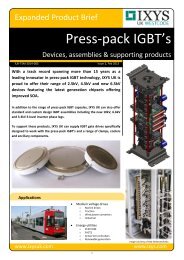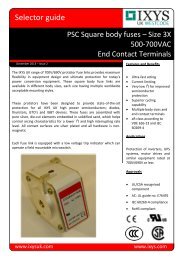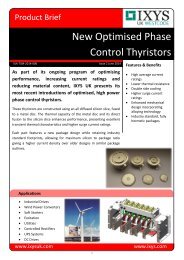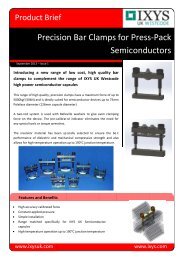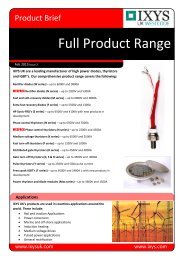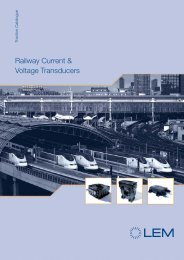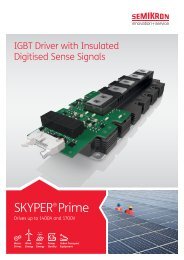isolated current voltage transducers
Create successful ePaper yourself
Turn your PDF publications into a flip-book with our unique Google optimized e-Paper software.
Hall Effect Technologies<br />
V A<br />
Î S<br />
V CE(sat)<br />
= ?<br />
R S<br />
= 80 Ω<br />
V S<br />
V Cmin<br />
= 14,25 V<br />
R M<br />
= 90 Ω<br />
Figure 12: Diagram for calculation of the available <strong>voltage</strong>, V A<br />
, at<br />
the output stage<br />
V A<br />
V CE(sat)<br />
= 2,35 V<br />
Example 3: Measuring <strong>current</strong> higher than the maximum<br />
value given in the datasheet<br />
LEM datasheets indicate the transducer operating conditions,<br />
with a measuring range that is generally limited to 150 to<br />
200 % of the nominal <strong>current</strong> (I PN<br />
). However, it is possible to<br />
measure <strong>current</strong>s exceeding this range if the following two<br />
parameters are considered:<br />
• the measurement resistance must not be smaller than the<br />
R Mmin<br />
value given in the datasheet; this minimum value is<br />
required to limit the power dissipated in the transducer<br />
output stage; depending on the selected transducer R Mmin<br />
can be very small, in some cases equal to zero<br />
• the primary conductor temperature must not exceed the<br />
value specified in the datasheet (e.g. 90 °C), to keep the<br />
transducer within acceptable operating temperature levels<br />
The following examples demonstrate the calculation of the<br />
maximum measurable <strong>current</strong>. Various scenarios are<br />
examined to address different types of LEM <strong>transducers</strong>.<br />
a) The datasheet requires an R Mmin<br />
value greater than zero.<br />
For example, the following parameters are defined for the<br />
LA 55-P transducer: V C<br />
= 15 V ± 5 %, T A<br />
= 70 °C, R S<br />
=<br />
80 Ω, R Mmin<br />
= 50 Ω, VA = 11.9 V (as calculated in example<br />
2a). The maximum value of the measurable secondary<br />
<strong>current</strong> is:<br />
I S<br />
= V A<br />
/ (R S<br />
+ R Mmin<br />
) = 11.9 V / (80 + 50)Ω = 91.5 mA<br />
The corresponding maximum measurable primary <strong>current</strong><br />
is 91.5 A.<br />
V M<br />
R S<br />
= 80 Ω<br />
R M<br />
= ?<br />
Î S<br />
V S<br />
V Cmin<br />
= 14,25 V<br />
Figure 13: Equivalent diagram to calculate the measuring<br />
resistance, R M<br />
V M<br />
b) The datasheet allows an R Mmin<br />
value equal to zero.<br />
For example, the following parameters are defined for an<br />
LA 305-S transducer: V C<br />
= 15 V ± 5 %, T A<br />
= 70 °C, I P<br />
= 300<br />
A, R S<br />
= 35 Ω (at 70 °C), R Mmin<br />
= 0 Ω, N P<br />
:N S<br />
= 1:2500. The<br />
minimum measurement resistance R M<br />
can be zero and it is<br />
up to the user to select the most suitable value. The<br />
smaller the value the larger the maximum measurable<br />
<strong>current</strong>, but the smaller the available output <strong>voltage</strong> signal.<br />
The available <strong>voltage</strong> at the amplifier output (V A<br />
) is<br />
determined as follows:<br />
R Mmax<br />
= 75 Ω at 300 A for V C<br />
= 15 V, I S<br />
= 300 A/2500 = 120 mA<br />
So:<br />
V A<br />
= (R S<br />
+ R Mmax<br />
) • I S<br />
= (35 + 75)Ω • 0.12 A = 13.2 V<br />
The maximum value of the measurable secondary <strong>current</strong><br />
depends on the selected measurement resistance.<br />
For example, with R M<br />
= 5 Ω, we have:<br />
I S<br />
= (V A<br />
-∆V C<br />
)/(R S<br />
+ R M<br />
) = (13.2 V) / (35 + 5)Ω = 330 mA<br />
The maximum measurable primary <strong>current</strong> is consequently<br />
equal to 330 mA • 2500 = 825 A, corresponding to<br />
2.75 • I PN<br />
. The <strong>voltage</strong> measured on the measurement<br />
resistance is V M<br />
= 330 mA • 5 Ω = 1.65 V.<br />
With R M<br />
= 2 Ω, we have I S<br />
= 357 mA, a maximum<br />
measurable primary <strong>current</strong> of 3 • I PN<br />
(892 A) with a smaller<br />
output <strong>voltage</strong> of 0.71 V.<br />
If a zero ohm measurement resistor is considered, the<br />
transducer can provide I S<br />
= 377 mA, which represents<br />
3.14 • I PN<br />
(943 A). This arrangement provides no output<br />
<strong>voltage</strong>, so a virtual ground referenced <strong>current</strong> to <strong>voltage</strong><br />
converter will be required to obtain a usable output signal.<br />
It is up to the user to decide exactly what is needed.<br />
Under these higher <strong>current</strong> conditions it is especially<br />
important to keep the temperature of the primary conductor<br />
below the maximum allowable temperature to avoid<br />
permanent damage.<br />
Example 4: Measuring transient <strong>current</strong> higher than the<br />
maximum value given in the datasheet<br />
In some cases higher <strong>current</strong>s can be measured using the<br />
<strong>current</strong> transformer effect, provided the frequency and/or the<br />
di/dt are high enough. This can be useful for short circuit<br />
detection, as this is typically a high di/dt event, but care must<br />
be exercised when attempting to use this capability for<br />
standard or continuous measurement. See § 3.2.3 for more<br />
details.<br />
It is important to note that some <strong>transducers</strong> (e.g. LTS) have<br />
an internal measurement resistor value that cannot be<br />
adjusted and, in these circumstances, the measuring range<br />
cannot be adjusted.<br />
17





